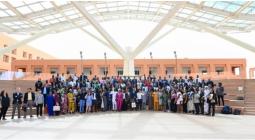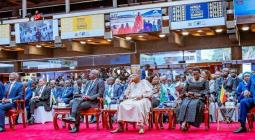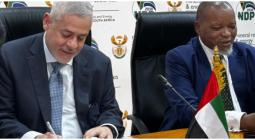Dimitri Fone: I dream of an electrified Africa,connected to the internet and to peace

Dimitri Fone was one of the 140 young African leaders who took part in the Bridge Africa Summit organised by the Université Mohammed VI Polytechnique (UM6P). This Cameroonian permanent resident of Morocco is a Strategy consultant and an automotive engineer. In this interview, he talks about his career, his vision of transport and his hopes for the continent's cities.
Dimitri Fone was one of the 140 young African leaders who took part in the Bridge Africa Summit organised by the Université Mohammed VI Polytechnique (UM6P). This Cameroonian permanent resident of Morocco is a Strategy consultant and an automotive engineer. In this interview, he talks about his career, his vision of transport and his hopes for the continent’s cities.
Benoit-Ivan Wansi: From 6 to 8 May 2024, you took part in the Bridge Africa Summit organised by Mohammed VI Polytechnic University (UM6P). What were your expectations for this event?
Dimitri Fone: My expectations can be summed up in two main points. Firstly, in terms of networking, i.e. meeting other young African leaders who, like me, have the desire and enthusiasm to help our continent shine. Secondly, my expectations related to the programme itself, which aims to set up a new leadership initiative that could stand out from what already exists.
Could you briefly outline your academic and professional background? Why did you choose Morocco to train and work in when many young Africans are more attracted to Europe and America?
I’m a Cameroonian “full-time dreamer” and very enthusiastic about the idea of contributing to the development of the African continent. Talking about my academic background, I obtained my scientific baccalaureate at François Xavier Vogt College in Yaoundé, Cameroon. I then won a scholarship to study at the Faculty of Science and Technology in Marrakech. Morocco wasn’t my first choice, but France was. After two years studying mathematics, computer science and physics, I had the opportunity to take part in a competitive examination at one of Morocco’s most prestigious engineering schools. This gave me the opportunity to work as an engineer in thermal design and performance, and so on. A little later, I moved to a consultancy firm.
The international automotive group Stellantis, for which you have worked in recent years, has set up a factory in the Moroccan town of Kénitra to produce its “Opel Rocks-e” electric vehicle. Did you play a specific role on the technical side?
I was just a young engineer at the start of my career. I had a general knowledge of the activities that took place there. But I was specifically involved in automotive research and development projects where I had to reassure myself about the performance and comfort of the engines.
How do you view electromobility at a time when decarbonisation policies are not to the taste of all carmakers and climate sceptics? Should electromobility be developed en masse until combustion-powered vehicles have disappeared, or should we simply sail along with both?
It’s a very tricky question. And to be quite frank, I have mixed feelings about it. Firstly, because I think that Africa needs to take this step towards electromobility. However, it’s not taking exactly the same path as others (the West, editor’s note) because the manufacture of electric vehicles, although useful for the ecological transition, is not necessarily carbon neutral in terms of the value chain that generates pollution (extraction of minerals for batteries, etc.). But their use does not damage local air quality. So I opt for a cohabitation between combustion engines and electric vehicles.
When we look at the energy problems we are facing in sub-Saharan Africa, electric cars are a spare wheel that should not be overlooked.
It’s also worth noting that some European cities, including London in the UK, are going to ban combustion-powered vehicles by 2030. As a result, some carmakers are realistic and are preparing for this. This is the case of Stellantis, which has drawn up a strategic plan for this transition.
In Casablanca, where you live, software has been taking control of road traffic since 2016. This is thanks to a surveillance system comprising 760 cameras connected to 220 kilometres of fibre optics. These are unimaginable initiatives in sub-Saharan Africa. Is it a lack of will, skills or finance that is holding back intelligent mobility in the region?
It’s not necessarily a lack of finances, because today the finances are there. I think that the problem today is the lack of prioritisation, which is not an easy exercise given that there are so many projects and, as a result, our leaders specifically don’t know what to work on.
It’s complicated to set up a monitoring system on the motorways of these sub-Saharan African countries, because before that can happen, the road infrastructure has to be adapted.
When we talk about reducing carbon dioxide (CO2) emissions from human travel, air transport is often forgotten. Having worked with the maintenance teams at Royal Air Maroc (RAM), can you tell us what airlines can do to reduce the environmental impact of their journeys?
My experience of a few months at RAM’s Technical Maintenance Centre was beneficial in that I actually got to grips with certain developments, such as estimating the carbon footprint of each passenger on board. The airlines are also focusing on research and development (R&D) to achieve the shared objective of having green hydrogen aircraft within the next 25 years. The fact that these issues are already being discussed and debated is a good sign for civil aviation.
Despite its efforts, the government in Yaoundé is not yet up to date with the implementation of the Sustainable Development Goals (SDGs). What kind of Cameroon do you dream of? Tell us about the ideal city you would like to see for your compatriots.
I dream of a Cameroon with just the right road infrastructure, where there are no more frequent power cuts and good digital connectivity for Internet access. So my own Africa is an imaginary city that’s connected and at peace, far from crises like the one that has been going on for several years in some parts of the country.
In the meantime, which Cameroonian city stands out in terms of sustainability?
Apart from the capital Yaoundé, I visited Limbe in the south-west region. It’s a city that I found extremely clean, incredible and resilient.





